For the top 10 challenges in coaching (and how to fix them), jump to this section.
–

Your client nods enthusiastically when you ask about their action steps.
They seem motivated and ready to tackle the world. But when you meet again next week, nothing has changed.
If you’ve been coaching for more than a few months, you’ve probably faced this scenario.
The global coaching industry revenue is predicted to hit $4.56 billion (source: International Coaching Federation), yet many of us still struggle with the same recurring challenges during our sessions.
You’re about to discover 10 proven fixes for the most common coaching obstacles, plus a grab-and-go checklist that will transform how you handle difficult moments.
I’ve also included guidance on tricky situations that rarely get discussed, like working with “forced” coachees and navigating cultural clashes.
Why These Challenges Can Make or Break Your Practice
Here’s what the research tells us, and it might surprise you.
Teams that receive high-quality coaching show 22% increase in bottom-line profitability (source: Coach Foundation) compared to those that don’t. That’s not a small difference.
But here’s the kicker: coaching engagements stall or fail when early goal alignment goes wrong. Think about that for a moment. Coaching relationships could succeed with better session management.
The financial impact hits you directly too.
- Mishandled sessions erode trust, extend engagement timelines, and hurt your reputation.
- Clients who feel unheard or misunderstood don’t refer others.
- They don’t renew contracts.
But when you master these challenges, something beautiful happens.
- Your clients achieve measurable results faster.
- They become your biggest advocates.
- Your practice grows through referrals rather than cold outreach.
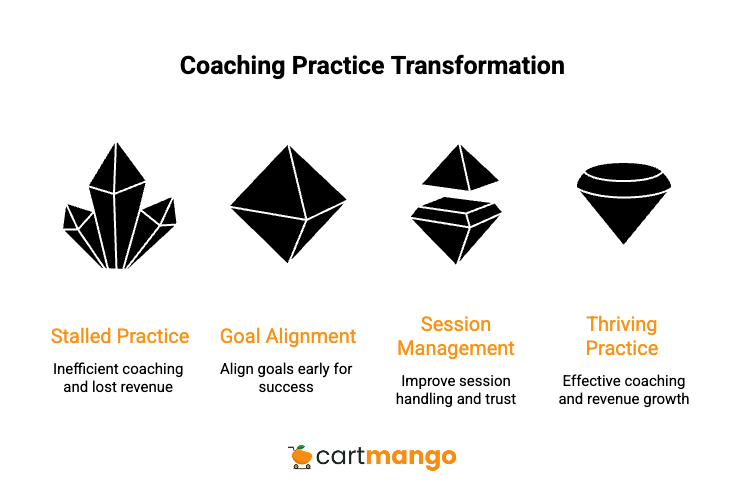
The 10 Most Common Challenges You’ll Face (And What to Do About Them)
Here’s a condensed table that provides an at-a-glance summary of the 10 challenges in coaching:
# | Challenge | How It Shows Up | Practical Fix |
|---|---|---|---|
1 | Resistance to Change | “Yes, but…” responses; missed actions | 3-Layer Empathy + micro-commit step |
2 | Vague Goals | “I just want to be better” statements | SMART-Plus Storyboard template |
3 | Lack of Accountability | Skipped homework; blame-shifting | Peer-text reminders + progress dashboard |
4 | Over-Dependence on Coach | Client seeks answers instead of insight | Socratic question script; autonomy checkpoints |
5 | Emotional Defensiveness | Closed body language; minimal sharing | SAFE Model (Safety → Acknowledge → Frame → Explore) |
6 | Misaligned Expectations | Scope creep; off-topic tangents | Session contract + recap email template |
7 | Cultural & Values Clash | Advice conflicts with client norms | Mini CQ self-assessment; values alignment exercise |
8 | Time Pressure | Rushed check-ins; shallow exploration | 20-minute Laser-Coaching structure |
9 | Confidentiality Concerns | Withholding sensitive information | Explicit confidentiality script; encrypted notes |
10 | Premature Closure | “I’m good” after surface wins | Future-pacing & ripple-effect questions |
This table serves as a quick diagnostic tool you can reference during sessions. When you notice one of these patterns emerging, you can quickly identify which challenge you’re dealing with and apply the corresponding fix.
The expanded text below provides the detailed how-to guidance…
–
1/ Resistance to Change

How it shows up:
Your client gives you “Yes, but…” responses every time you suggest something new. They agree to take action, then come back with excuses about why they couldn’t follow through.
What’s really happening:
Change feels threatening to their identity. They’re not being difficult on purpose, they’re protecting themselves from potential failure or judgment.
The fix:
Use what I call the 3-Layer Empathy approach.
- First, acknowledge their resistance without judgment.
- Second, explore what change means to them personally.
- Third, find the smallest possible step they can commit to right now.
Here’s how it sounds:
“I hear you saying you want to improve your presentation skills, and I also hear some concern about looking foolish. What would feel like a safe first step for you?”
Then secure one micro-commit before the session ends. Not a big goal, just one tiny action they can take within 24 hours. Schedule a quick check-in text or call to maintain momentum.
–
2/ Vague Goals
How it shows up:
“I just want to be better at my job” or “I need to improve my relationships” without any specifics about what better looks like.
What’s really happening:
They know something needs to change, but they haven’t done the mental work to define success clearly. Sometimes they’re afraid that being specific will make them accountable.
The fix:
Convert their wish into a SMART-Plus goal using a visual storyboard. SMART-Plus adds “Exciting” and “Reviewed” to the traditional SMART framework.
Start with this question:
“If we could fast-forward six months and you were completely satisfied with your progress, what would you be doing differently?”
Then break down their answer into specific, measurable components.
Map their first milestone on paper or a shared screen. Show them exactly what the journey from current state to desired state looks like. Make it visual and concrete.
–
3/ Lack of Accountability
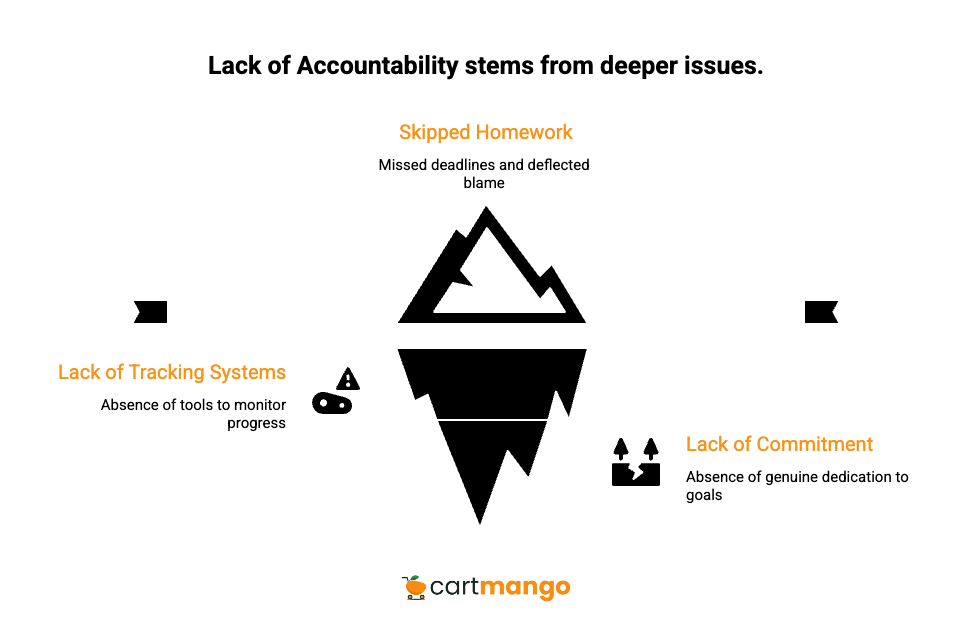
How it shows up:
Homework gets skipped. Deadlines get missed. Your client shows up unprepared and deflects responsibility with external blame.
What’s really happening:
They lack systems to track progress, or they don’t feel genuinely committed to the outcomes they agreed to pursue.
The fix:
Build a shared progress dashboard that both of you can see. Use a simple Google Sheet where they log daily actions and results.
Set up peer-text reminders with their permission. This isn’t about being pushy, it’s about creating gentle accountability touchpoints throughout the week.
Review their streak data at the beginning of each session. Celebrate wins, even small ones. When they miss targets, focus on adjusting the system rather than criticizing their effort.
–
4/ Over-Dependence on You
How it shows up:
They constantly ask “What should I do?” instead of exploring options themselves. They want you to solve their problems rather than building their own problem-solving skills.
What’s really happening:
They’ve learned to rely on external validation and direction. This pattern often starts in childhood and continues through their career.
The fix:
Master the art of Socratic questioning. Instead of giving answers, ask questions that help them discover insights themselves.
- Start with: “What options have you considered?”
- Then: “What would you try first if you had to decide right now?”
- Finally: “What’s your gut telling you about this situation?”
Insert autonomy checkpoints throughout your sessions. Every time they ask for your opinion, redirect with a question that puts them back in the driver’s seat.
Assign them a weekly self-reflection log where they record challenges, potential solutions, and decisions they made independently. Review this together to reinforce their growing autonomy.
–
5/ Emotional Defensiveness
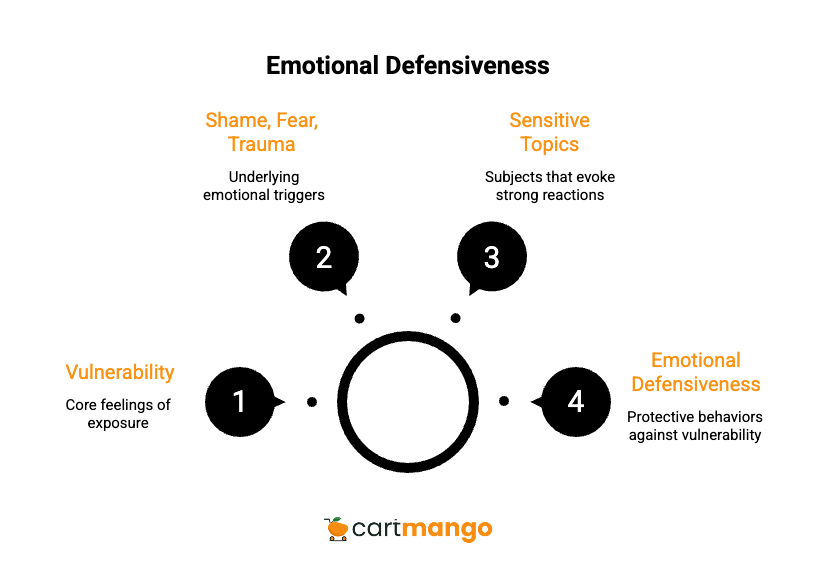
How it shows up:
They cross their arms, give short answers, or shut down when you touch on sensitive topics. Their body language screams “stay away from this subject.”
What’s really happening:
You’ve hit something that triggers shame, fear, or past trauma. They’re protecting themselves from feeling vulnerable or exposed.
The fix:
Apply the SAFE Model consistently. Safety first, then Acknowledge, then Frame, then Explore.
Safety means slowing down and reaffirming your confidentiality agreement. Acknowledge their emotion without trying to fix it immediately. Frame the topic as optional exploration, not mandatory discussion. Only then explore next steps together.
Here’s what it sounds like:
“I notice this topic seems to bring up some discomfort for you. That’s completely normal and you’re in control of how much we discuss. What would feel most helpful right now?”
Always validate their emotions before moving into problem-solving mode. Defensiveness usually melts when people feel truly heard and understood.
The American Psychological Association has published guidelines on creating psychological safety that apply directly to coaching relationships.
–
6/ Misaligned Expectations
How it shows up:
Sessions drift off-topic. They want to discuss things outside your agreed scope. They expect instant results or magical transformations.
What’s really happening:
You didn’t establish clear boundaries upfront, or circumstances have changed since your initial agreement.
The fix:
Create a written session contract that both of you sign. Include scope, timeline, your respective responsibilities, and what success looks like.
Send a recap email within two hours of each session. Summarize what you discussed, what they committed to, and what you’ll focus on next time.
Request written confirmation of next steps, not just verbal agreement. This creates clarity and prevents misunderstandings later.
When scope creep happens, address it immediately:
“This is an important topic, and it’s outside what we agreed to work on together. Would you like to adjust our focus, or should we address this separately?”
–
7/ Cultural and Values Clash

How it shows up:
Your advice conflicts with their cultural norms, family expectations, or personal values. They seem uncomfortable with your suggestions but won’t say why.
What’s really happening:
There’s a mismatch between your coaching approach and their cultural context. What seems logical to you might feel impossible or inappropriate to them.
The fix:
Run a mini Cultural Intelligence (CQ) assessment together. Ask directly about potential cultural or value conflicts with your suggestions.
When you identify a clash, don’t try to convince them to change their values. Instead, co-create culturally respectful alternatives that honor both their goals and their context.
Sample questions:
- “How would your family react to this change?”
- “What values are most important to you in this situation?”
- “How can we adapt this approach to fit your cultural context?”
–
8/ Time Pressure
How it shows up:
Your sessions feel rushed. You barely scratch the surface before you’re out of time. Deep exploration gets sacrificed for quick fixes.
What’s really happening:
You’re trying to cover too much ground without prioritizing what matters most to them right now.
The fix:
Adopt a 20-minute Laser-Coaching structure that maximizes impact in minimal time.
- Minutes 1-3: Context check-in. What’s most important today?
- Minutes 4-15: Deep dive on one specific challenge or opportunity.
- Minutes 16-20: Clear action plan with specific next steps.
Use timed five-minute reflection blocks within longer sessions. Set a timer and focus completely on one question or exercise.
End every session with a timestamped action plan. Not vague commitments, but specific tasks with deadlines attached.
–
9/ Confidentiality Concerns
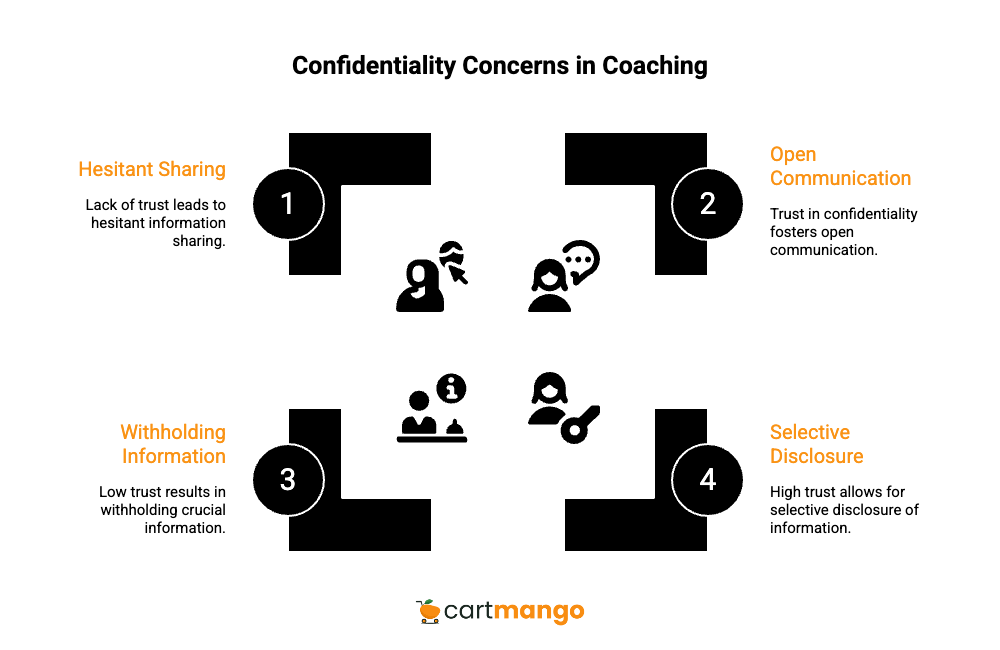
How it shows up:
They hold back crucial information that would help you coach them better. They seem worried about what you’ll do with what they share.
What’s really happening:
They’re not completely confident that their information will stay private, especially in organizational coaching situations.
The fix:
Restate your confidentiality clause verbally at the beginning of sensitive conversations. Don’t assume they remember or understand the boundaries.
Offer encrypted note-taking and file-sharing options. Show them exactly how you protect their information.
Invite them to review any notes or assessments you keep about them. Transparency builds trust faster than promises.
Be explicit about what you would and wouldn’t share, even if asked by their boss or organization. Clear boundaries reduce anxiety and encourage openness.
–
10/ Premature Closure
How it shows up:
They declare “I’m good” or “I’ve got this figured out” after achieving surface-level wins. They want to end coaching before addressing deeper patterns.
What’s really happening:
They’re afraid of continued vulnerability, or they genuinely believe that one success means they’ve solved everything.
The fix:
Future-pace the impact of their current changes six months down the road. Help them see potential challenges they haven’t considered yet.
Ask ripple-effect questions:
- “What other areas of your life might be affected by this change?”
- “What obstacles might emerge as you continue growing?”
- “What would you want to be different a year from now?”
Agree on a deeper exploration topic for your next session before they leave. This creates continuity and prevents the illusion that all problems are solved.
Sometimes premature closure is actually appropriate. Trust your judgment about when someone is genuinely ready to move forward independently.
Quick-Reference Checklist
Print this out and keep it handy during your sessions.
Check off items as you address them:
Resistance to Change
- Apply 3-Layer Empathy approach
- Secure one micro-commit before session ends
- Set 24-hour accountability ping
Vague Goals
- Transform wish into SMART-Plus statement
- Plot first milestone on visual storyboard
- Confirm specific success metric
Lack of Accountability
- Build shared progress dashboard
- Schedule peer-text reminder system
- Review streak data at next session start
Over-Dependence on Coach
- Start with Socratic question prompt
- Insert autonomy checkpoint mid-session
- Assign weekly self-reflection log
Emotional Defensiveness
- Re-affirm psychological safety norms
- Acknowledge emotion without immediate judgment
- Re-frame topic collaboratively
- Agree on small, non-threatening next step
Misaligned Expectations
- Clarify session scope at start
- Send recap email within 2 hours
- Obtain written confirmation of commitments
Cultural and Values Clash
- Complete mini CQ assessment together
- Identify specific conflicting values
- Co-design culturally respectful alternative
Time Pressure
- State laser-coaching agenda upfront
- Use timed reflection blocks
- End with timestamped action plan
Confidentiality Concerns
- Restate confidentiality clause verbally
- Offer encrypted note-taking option
- Invite client to review stored data
Premature Closure
- Future-pace impact 6 months ahead
- Ask ripple-effect questions
- Schedule deeper follow-up topic
Copy this checklist to your phone or print it out. Having it visible during sessions helps you stay systematic when challenges arise.
The beauty of this checklist is that it works whether you’re dealing with executive coaching, life coaching, or any other specialization. The human dynamics remain consistent across contexts.
Edge Scenarios (that test your skills)
Most coaching challenges fit into the 10 categories above, but some situations require special handling.
Here are the edge cases that can make or break your coaching career:
“Forced” Coachees
When someone’s boss mandates coaching, resistance runs deep. They didn’t choose you, and they might resent the implication that they need help.
Use a rapport-first protocol. Spend your first session acknowledging their situation directly: “I know you didn’t choose to be here, and I respect that this might feel uncomfortable.”
Negotiate shared goals that serve both their interests and their organization’s needs. Find the overlap between what they want and what their boss wants.
Revisit their motivation at regular checkpoints. People’s attitudes toward coaching often shift once they experience genuine benefit.
–
High-Achiever Imposter Syndrome
Successful people often struggle with feeling like frauds. They worry that someone will discover they don’t belong at their level of success.
Deploy a strengths-reframing exercise. Help them see their achievements as evidence of competence rather than lucky accidents.
Set micro-venturing tasks that build additional evidence of their capabilities. Small wins accumulate into unshakeable confidence.
–
Ethical Dilemmas
Sometimes clients share information about behavior that could harm others. You’re caught between confidentiality and responsibility.
Follow the ICF decision framework: identify all stakeholders, consult the ethical code, document your reasoning, then act consistently with your professional obligations.
When in doubt, consult with other coaches or your professional association. Ethical decisions shouldn’t be made in isolation.
–
Virtual-Session Fatigue
After years of video calls, many clients are exhausted by screen-based interactions. Traditional coaching formats feel stale and draining.
Offer camera-optional “walk-and-talk” sessions where both of you take calls while walking outside. Movement stimulates creativity and reduces pressure.
Inject two-minute stretch breaks into longer sessions. Physical movement refreshes mental energy.
Alternate between audio-only calls, video sessions, and asynchronous communication. Variety prevents monotony and maintains engagement.
These edge scenarios separate good coaches from great ones. They require flexibility, creativity, and strong ethical grounding.
Building Your Coaching Practice and Business Beyond Challenges
Once you’ve mastered the above hurdles, your coaching business faces entirely different obstacles. The coaching process extends far beyond individual conversations into the realm of business operations and client acquisition.
Your coaching practice requires the same systematic approach you use during sessions. You need a solid business plan that accounts for marketing efforts, scheduling software, and the digital tools that keep everything running smoothly. These aren’t just nice-to-haves, they’re essential for any coach who wants to build their own business.
The Business Management Reality
Many coaches struggle with the transition from focusing purely on coaching effectiveness to managing business operations. You might excel at establishing expectations with clients, but find yourself overwhelmed by the administrative side of your coaching business.
Here’s what separates successful coaching practices from those that plateau:
- Clear business plan that outlines your coaching room setup, whether physical or virtual
- Streamlined client acquisition process that doesn’t depend on constant hustle
- Scheduling software that eliminates the back-and-forth email dance
- Marketing efforts that authentically represent your coaching experience
The International Coaching Federation reports that coaches who invest in business management skills alongside their coaching skills see higher client retention rates. This isn’t about becoming a business expert overnight, it’s about recognizing that your coaching practice succeeds when both you and your clients can focus on the work rather than logistical headaches.
Digital Tools
You don’t need every shiny new platform that promises to revolutionize your practice. Focus on tools that serve three core functions: scheduling, communication, and progress tracking.
Your scheduling software should integrate with your calendar and send automatic reminders. Your communication platform should protect client confidentiality while allowing easy file sharing. Your progress tracking system should help both you and your clients see meaningful progress over time.
Industry trends show that coaches who embrace digital tools without getting overwhelmed by them create more supportive environments for their clients. The technology should disappear into the background, leaving space for meaningful relationships to develop.
Developing Your Coaching Skills and Professional Growth
The coaching skills that got you started aren’t necessarily the ones that will take you to mastery. Professional development in coaching requires continuous improvement across multiple dimensions simultaneously.
Beyond Basic Coach Training
Your initial training program gave you the foundation, but real coaching experience teaches you things no certification can cover. You learn to practice active listening not just as a technique, but as a way of creating mutual understanding with every client you serve.
Advanced certifications become valuable when they address specific gaps in your coaching effectiveness. The International Coaching Federation offers specialized tracks that help coaches face the evolving challenges of their field.
Consider these areas for ongoing professional development:
- Active listening skills that go beyond nodding and summarizing
- Encouraging self reflection without pushing clients into uncomfortable territory
- Establishing expectations that create mutual respect from the first interaction
- Work life balance strategies that prevent coaching burnout
The Coach’s Role in Professional Growth
Your role extends beyond helping clients reach their career goals. You’re modeling continuous improvement, self awareness, and the willingness to regularly review your own performance measures.
New coaches often focus exclusively on client needs without recognizing their own need for professional growth. This creates a ceiling on their coaching effectiveness that’s hard to break through later.
Experienced coaches understand that encouraging self reflection works both ways. When you self reflect on your coaching practice, you identify areas where you can remain relevant and overcome barriers that limit your impact.
Measuring Your Own Progress
Just as you help clients measure progress toward their desired outcome, you need clear performance measures for your own development. This isn’t about comparing yourself to other coaches, it’s about tracking your growth over time.
Ask yourself these questions quarterly:
- What deeper insights am I gaining about human change and growth?
- How has my ability to identify areas for improvement evolved?
- What barriers have I learned to overcome this year?
- How do I maintain work life balance while growing my practice?
The coaches who thrive long-term are those who view their own development as seriously as they view their clients’ growth.
Creating Effective Client Relationships and Measuring Success
The foundation of impactful coaching lies in the quality of client relationships you build. These relationships require more than good intentions, they need systematic approaches to creating meaningful progress.
Building Trusting Coaching Relationships
Your initial interactions set the tone for everything that follows. Clients form impressions about your coaching effectiveness within the first few minutes of meeting you. This pressure can feel overwhelming, but it’s also an opportunity to establish clear expectations right from the start.
Mutual understanding doesn’t happen automatically. You create it through consistent behavior, active listening, and by providing ongoing support that adapts to each client’s personal life circumstances.
The Art of Establishing Expectations
Clear expectations prevent most client relationship problems before they start. When both you and your client understand the coaching process, boundaries, and desired outcomes, you create space for meaningful relationships to develop.
Unrealistic expectations, on the other hand, poison even the most well-intentioned coaching partnerships. Address these directly during your initial interactions rather than hoping they’ll resolve themselves over time.
Here’s how to establish clear expectations that stick:
- Define the coaching process step by step
- Explain your coach’s role and their responsibilities
- Identify areas where you’ll provide ongoing support
- Discuss what meaningful progress looks like for their specific situation
Measuring What Matters
Successful coaching requires measuring progress in ways that matter to your clients. This goes beyond tracking action items to understanding how changes in their personal and professional development affect their overall life satisfaction.
Use open ended questions to help clients self reflect on their progress. “What’s different now compared to three months ago?” reveals more than any formal assessment tool.
Your clients need to find their own answers to create lasting change. When you provide valuable insights rather than solutions, you help them develop the self awareness that drives continuous improvement.
The most effective coaching relationships are built on mutual respect and a shared commitment to meaningful progress. These relationships create supportive environments where both personal growth and professional development can flourish naturally.
Key challenges like client acquisition and marketing efforts become easier when you focus first on creating the kind of impactful coaching that generates valuable insights for your clients. When you consistently deliver this level of service, your reputation builds itself.
Your Turn
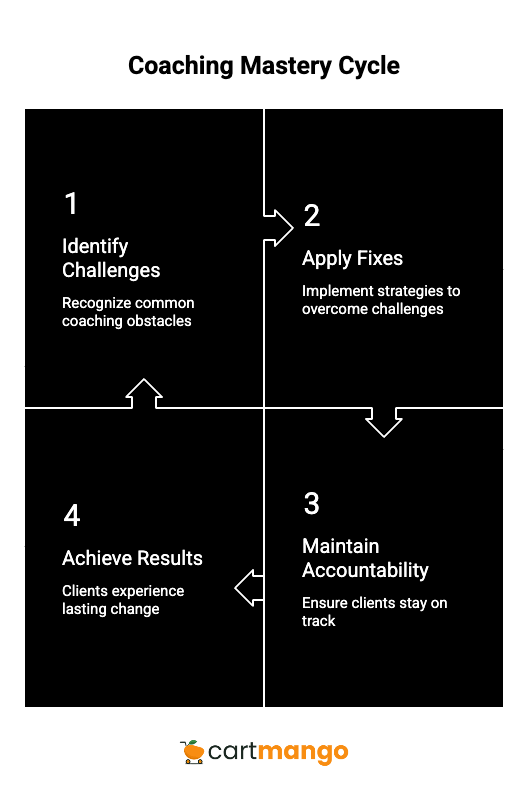
Mastering these session-level challenges transforms every coaching conversation into a catalyst for measurable change. When you can navigate resistance, clarify goals, and maintain accountability, your clients achieve results that stick.
The difference between coaches who thrive and those who struggle often comes down to how well they handle these common obstacles. Armed with these fixes and your quick-reference checklist, you’re prepared for whatever challenges arise.
Here’s what I want you to do next:
Download and print the checklist above. Keep it visible during your next five coaching sessions. Notice which challenges come up most frequently for you.
Every master coach has faced these same challenges. The difference is that they developed systematic approaches to handle them. Now you have those same systems.
Related
- Sellfy vs Payhip: The Recurring Revenue Prison (2026)
- Podia vs Gumroad: The Recurring Revenue Handcuffs (2026)
- SendOwl vs Gumroad: The Recurring Revenue Black Hole (2026)
- Gumroad vs Sellfy: The Vendor Lock-in Cage (2025)
- Gumroad vs Payhip: The Hidden Trap for Creators (2025)
- ThriveCart vs SamCart – The Subscription Hostage Trap (2025)
- 8 ThriveCart Alternatives & The Lifetime Pricing Paradox (2025)
- 8 SamCart alternatives + Subscription hostage (2025)
- The GENTLE Method: Soft marketing for creators
- How Far in Advance Should You Promote a Webinar?
